Restore of my 1986 Bronco XLT
|
Administrator
|
You have it connected correctly. The hose near the cap goes to the overflow reservoir and the lower one goes to pre-heat on the EFI system - if your system uses that. But Ford decided after a few years that the pre-heat isn't needed so most of the radiators are capped there. However, that port is under full pressure so it cannot be connected to the recovery reservoir w/o problems.
As for not having coolant in the reservoir, you apparently don't have the cooling system completely full. If the system is full up to the neck of the radiator and has no air in it then when the coolant gets hot and expands the pressure valve in the cap will open and coolant will come out into the reservoir. After you've driven the truck and it cools down completely, like over night, pull the radiator cap and fill the system up until it is FULL. Put the cap on and then put coolant in the overflow reservoir - maybe 2" of coolant or up to the Full Cold line if yours has that. It may take two or three rounds of driving/cooling/filling, but once you get the cooling system full and all the air out you can check the level of coolant just by watching the reservoir. When cold it should be at the same place every time. If not, you have a leak.
Gary, AKA "Gary fellow": Profile
Dad's: '81 F150 Ranger XLT 4x4: Down for restomod: Full-roller "stroked 351M" w/Trick Flow heads & intake, EEC-V SEFI/E4OD/3.50 gears w/Kevlar clutches
|
|
Ok, i will fill it that way. But it's very interesting, that I have driven like that over the apls at about 35 degrees Celsius without having problems...

René's Profile
Bronco 1986 Ford Bronco XLT 302/347 stroker with 351W EEC-IV and 351W factory cam C6 gearbox. Jeep 1986 Jeep CJ7 256 I6 with T5 gearbox. Buggy 1972 HAZ Buggy 122 Ford Cologne V6 Baron 1994 Chrysler LeBaron convertible 183 V6 4-speed automatic |
|
Administrator
|
René - I remembered this morning that I have a copy of Ford's Service Technician Specialty Training (STST) manual on Engine Cooling System & Components. So I scanned it in and put it on the page at Documentation/Cooling Systems/Engine Cooling System Training Manual. You might want to look at pages 9 - 12 for a better explanation than I've given of the radiator cap, coolant recovery reservoir, and thermostat.
As for having driven over the Alps at 35C, that's "only" 95F. We frequently see well over that and a properly maintained system handles that fairly easily. But if you don't have a coolant recovery reservoir then when it gets up to those temps it will push coolant out due to expansion. And when your system cools it'll suck air back in where you once had coolant. So now you have less coolant in the system. That air then may get trapped in the system in high spots and more coolant comes out as the system heats up. So you may continually lose coolant and ultimately overheat. Yes, you can get by w/o a coolant recovery reservoir. But your system isn't working as well as it was designed to work.
Gary, AKA "Gary fellow": Profile
Dad's: '81 F150 Ranger XLT 4x4: Down for restomod: Full-roller "stroked 351M" w/Trick Flow heads & intake, EEC-V SEFI/E4OD/3.50 gears w/Kevlar clutches
|
|
Ok. Thanks Gary!
I haven't the original cap installed...maybe this is the problem? 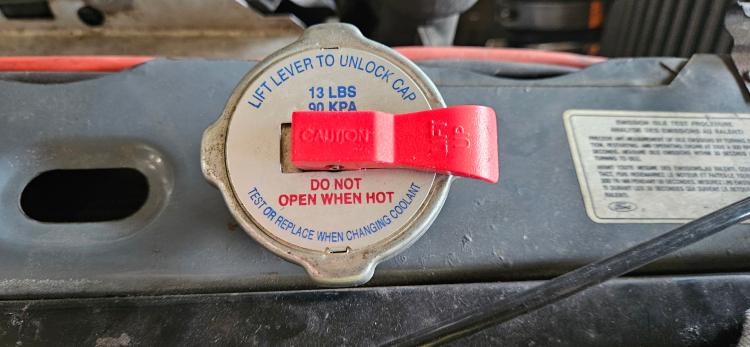 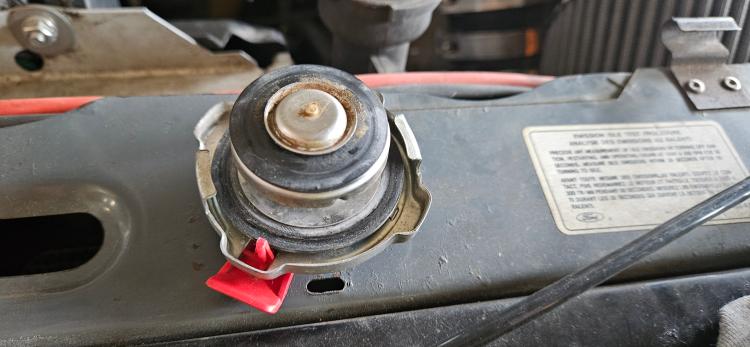 I will follow your instructions to fill the coolant system. I have no markings on the reservoir.
René's Profile
Bronco 1986 Ford Bronco XLT 302/347 stroker with 351W EEC-IV and 351W factory cam C6 gearbox. Jeep 1986 Jeep CJ7 256 I6 with T5 gearbox. Buggy 1972 HAZ Buggy 122 Ford Cologne V6 Baron 1994 Chrysler LeBaron convertible 183 V6 4-speed automatic |
|
Administrator
|
I don't know that you have a problem. I'm thinking that you've never gotten the system completely full and then kept coolant in the recovery reservoir. It does no good to get the system completely full if there isn't coolant kept in the recovery reservoir to suck back in when everything cools.
So give it a try with that cap. I'm not sure there is anything wrong with it. At least it has all of the needed bits: Yellow: This seal is the one that keeps pressure on the system until it reaches 13 psi, at which point it overcomes the spring and lets coolant out into the neck of the radiator and then on into the recovery reservoir.Red: That is the seal at the top of the radiator's neck, and it channels the coolant to the reservoir when the spring opens and lets it out. But when things cool it ensures that there's a tight seal so a vacuum is drawn in the radiator.Green: The check valve closes with pressure, but as the system cools and a vacuum forms it opens and the vacuum sucks coolant back in from the recovery reservoir.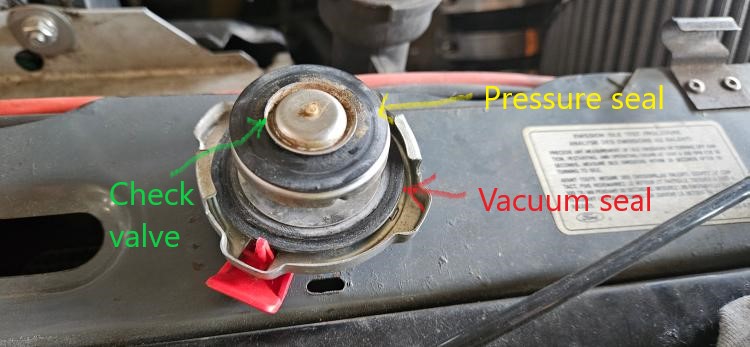
Gary, AKA "Gary fellow": Profile
Dad's: '81 F150 Ranger XLT 4x4: Down for restomod: Full-roller "stroked 351M" w/Trick Flow heads & intake, EEC-V SEFI/E4OD/3.50 gears w/Kevlar clutches
|
|
This post was updated on .
So, after changing the TPS to the 1994-Type from Motorcraft and also the C6 modulator, the problem still occurs.
Trying to accelerate slowly, when driving a constant speed with warm Engine, there is a lack of power and the engine misfires. It feels that the misfire only happen on the driver's side. I feel it at the floor panel. It only occurs when: - the engine is warm. - at part throttle, trying to accelerate slowly. - when driving It doesn't occurs when: - in parking position varying the throttle position slowly. - driving, releasing the pedal a bit and pushing it even more, that's needed. RPM raises faster and there is no feelable lack of power. After the error occurs and slow down the car until it holds, it got a raw idle. The engine is sawing. This behavior vanishes after switching off the engine and restart some minutes later. As changing the TPS and fixing the new one, I noticed, that one of the two screws can't be fixed tight. It seems, that there is something wrong with the thread inside the throttle body. I have checked and set the TPS voltage, with engine off. 0.9 to 4.7V Maybe the throttle sometimes moves the TPS sensor when it's getting warm, cause it isn't fixed correctly... If this is not the reason, I only can imagine that one of the temperature related sensors is defective. Another point I've thought about us, if it is possible that the alternator can have caused an over-voltage or overcurrent and damaged something... I hope this behavior has nothing to do with the metallic sound that one of the pushrods does, when the engine is cold...I have told about this in the past. It hasn't changed. So it doesn't get worse or better. But I can't imagine this as the reason, cause in my understanding, if a valve won't open or close correctly, it will do it in a regular way and it doesn't matter the throttle position... That's the current situation. I'm happy about all input I can get to solve it.
René's Profile
Bronco 1986 Ford Bronco XLT 302/347 stroker with 351W EEC-IV and 351W factory cam C6 gearbox. Jeep 1986 Jeep CJ7 256 I6 with T5 gearbox. Buggy 1972 HAZ Buggy 122 Ford Cologne V6 Baron 1994 Chrysler LeBaron convertible 183 V6 4-speed automatic |
|
Administrator
|
I'm lost. I don't understand. I'm going to tag Bill as he's dealt with the EEC-IV system much more than I have.
Bill - This started after he left the lights on and took the battery voltage low. But he's driven the truck and it doesn't seem to be learning, so while I thought it would learn and fix the lean problem it doesn't. Could we have a bad O2 sensor?
Gary, AKA "Gary fellow": Profile
Dad's: '81 F150 Ranger XLT 4x4: Down for restomod: Full-roller "stroked 351M" w/Trick Flow heads & intake, EEC-V SEFI/E4OD/3.50 gears w/Kevlar clutches
|
|
Hmm...O2-Sensor...
Maybe it got too much of the burnt ATF, that the engine sucks out of the C6 modulator... As the sensor only works, when it's warm, it may a possibility...how can I check it? I can easily access the cable from it to the ECU.
René's Profile
Bronco 1986 Ford Bronco XLT 302/347 stroker with 351W EEC-IV and 351W factory cam C6 gearbox. Jeep 1986 Jeep CJ7 256 I6 with T5 gearbox. Buggy 1972 HAZ Buggy 122 Ford Cologne V6 Baron 1994 Chrysler LeBaron convertible 183 V6 4-speed automatic |
|
Administrator
|
I don't know that you can check an O2 sensor. You don't know what air/fuel ratio it is seeing so don't know what its output should be. And it is especially difficult with the narrow-band sensor(s) you have since they only show the right output at a very precise AFR.
So I'm wondering if it has been damaged due to the ATF in the fuel and, therefore, exhaust? And can driving with no ATF in the fuel correct it?
Gary, AKA "Gary fellow": Profile
Dad's: '81 F150 Ranger XLT 4x4: Down for restomod: Full-roller "stroked 351M" w/Trick Flow heads & intake, EEC-V SEFI/E4OD/3.50 gears w/Kevlar clutches
|
|
Hmm...you are asking good questions.
I also don't know. It's interesting that this appears since the low battery... It's like my beginning with the injectors...but today, all cable in the engine bay are new and in very good condition...  So, something else seems to be wrong.
René's Profile
Bronco 1986 Ford Bronco XLT 302/347 stroker with 351W EEC-IV and 351W factory cam C6 gearbox. Jeep 1986 Jeep CJ7 256 I6 with T5 gearbox. Buggy 1972 HAZ Buggy 122 Ford Cologne V6 Baron 1994 Chrysler LeBaron convertible 183 V6 4-speed automatic |
Re: Restore of my 1986 Bronco XLT
|
Administrator
|
Rene' The normal O2 sensor is a narrow band device, it produces a voltage signal related to the % O2 in the ehaust stream. I was trying to find a diagram of the voltage curve, but came across this:
Why do O2 sensors fail? Since the oxygen sensor is in the exhaust stream, it can become contaminated. Common sources of contamination include an excessively rich fuel mixture condition or oil blow-by in an older engine and engine coolant being burnt in the combustion chamber as a result of an engine gasket leak. It is also exposed to extremely high temperatures, and like any component can wear over time. These can all affect the oxygen sensor’s response characteristics, resulting in an extended response time or a shift in the sensor voltage curve and in the long run reduced sensor performance. Hopefully this will at least help. Are you running a heated O2 sensor? Is it still in the original 1986 location? The paragraph above would lead me to agree with Gary the O2 sensor may be bad.
Bill AKA "LOBO" Profile
"Getting old is inevitable, growing up is optional" Darth Vader 1986 F350 460 converted to MAF/SEFI, E4OD 12X3 1/2 rear brakes, traction loc 3:55 gear, 160 amp 3G alternator Wife's 2011 Flex Limited Daily Driver 2009 Flex Limited with factory tow package Project car 1986 Chrysler LeBaron convertible 2.2L Turbo II, modified A413 |
|
Administrator
|
 I just quoted the same thing back to you via email. I just quoted the same thing back to you via email.
Yes, the ATF may have shifted the band just enough where the ECU thinks it has a 14.7:1 AFR when it is actually something like 16:1. That could make the engine doggy and maybe even miss under light throttle.
Gary, AKA "Gary fellow": Profile
Dad's: '81 F150 Ranger XLT 4x4: Down for restomod: Full-roller "stroked 351M" w/Trick Flow heads & intake, EEC-V SEFI/E4OD/3.50 gears w/Kevlar clutches
|
|
In reply to this post by 85lebaront2
Hi Bill,
I use this heated O2 sensor from Bosch: Rockauto It's located in the downpipe of the passenger side. Maybe I should clean it? Can this help? I've driven today about 25 miles without any changes in behavior.
René's Profile
Bronco 1986 Ford Bronco XLT 302/347 stroker with 351W EEC-IV and 351W factory cam C6 gearbox. Jeep 1986 Jeep CJ7 256 I6 with T5 gearbox. Buggy 1972 HAZ Buggy 122 Ford Cologne V6 Baron 1994 Chrysler LeBaron convertible 183 V6 4-speed automatic |
Re: Restore of my 1986 Bronco XLT
|
Administrator
|
Rene' I am not sure they can be sucessfully cleaned as the heater should burn off the ATF, but, like anything you burn there is usually some residue, ashes or anything that won't burn. Since you are going to have to remove it anyway, I would get a new one and install it.
Bill AKA "LOBO" Profile
"Getting old is inevitable, growing up is optional" Darth Vader 1986 F350 460 converted to MAF/SEFI, E4OD 12X3 1/2 rear brakes, traction loc 3:55 gear, 160 amp 3G alternator Wife's 2011 Flex Limited Daily Driver 2009 Flex Limited with factory tow package Project car 1986 Chrysler LeBaron convertible 2.2L Turbo II, modified A413 |
|
Ok, as I'm not exactly knowing what this error causes, I've decided to order some more spare-parts.
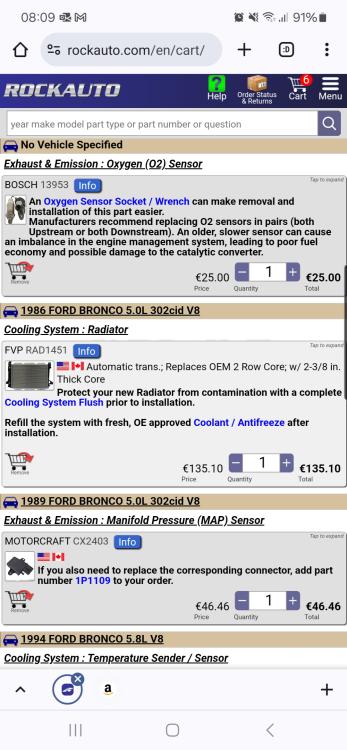 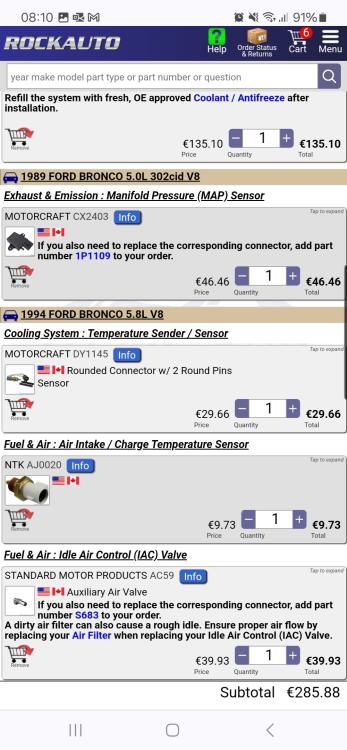 I've also added a new radiator, cause since I've flushed the cooling system like Gary told me, my original radiator is dripping on the passenger side and I can't see from where is comes. I know the the drain plug is broken and can't turned out. I've tried this already in the past. As I've replaced all sensors in the past, I might got a bad one by factory. I also have a new fuel pump and a new pressure regulator in my stock. - only to be save. If the ATF has entered the vacuum system, it may be able to damage other connected devices like the MAP or the pressure regulator, that may not be able to deal with ATF on the vacuum connection side. What do you think about this strategy?
René's Profile
Bronco 1986 Ford Bronco XLT 302/347 stroker with 351W EEC-IV and 351W factory cam C6 gearbox. Jeep 1986 Jeep CJ7 256 I6 with T5 gearbox. Buggy 1972 HAZ Buggy 122 Ford Cologne V6 Baron 1994 Chrysler LeBaron convertible 183 V6 4-speed automatic |
|
Administrator
|
I'm not an expert, but depending on where your MAP sensor is I can see the ATF may have gotten there. However, I doubt it would have hurt the MAP sensor nor the fuel pressure regulator.
But I think the air charge temp sensor is upstream enough that it wouldn't have seen the ATF, and the coolant temp sensor can't have seen it. But it won't hurt to have the spares. As for the radiator, if the one you have is leaking then it is time to replace it - unless you have a shop there that repairs radiators. Most here have gone out of business and probably have there as well.
Gary, AKA "Gary fellow": Profile
Dad's: '81 F150 Ranger XLT 4x4: Down for restomod: Full-roller "stroked 351M" w/Trick Flow heads & intake, EEC-V SEFI/E4OD/3.50 gears w/Kevlar clutches
|
Re: Restore of my 1986 Bronco XLT
|
Administrator
|
In reply to this post by ReneH
Rene' the MAP sensor, if it is in the original location for the 1986 trucks, possibly could have gotten some ATF in it, but before I "shotgunned" parts at it, I would pull the hose off and see if there is any ATF in there.
Radiator, I hope you get a good one, unfortunately some of the aftermarket parts I have run across are not that great.
Bill AKA "LOBO" Profile
"Getting old is inevitable, growing up is optional" Darth Vader 1986 F350 460 converted to MAF/SEFI, E4OD 12X3 1/2 rear brakes, traction loc 3:55 gear, 160 amp 3G alternator Wife's 2011 Flex Limited Daily Driver 2009 Flex Limited with factory tow package Project car 1986 Chrysler LeBaron convertible 2.2L Turbo II, modified A413 |
|
Yes, I'm with you both. But unless I haven't found the reason for the behavior, I feel much saver to have replacement for all sensors in stock. It's also possible, that one has failed and the ATF has nothing to do with it.
Regarding the radiator, I will buy the one from which I've done a screenshot. There are also some full-aluminium types available on the aftermarket, 3-row-types. But I'll try the one from the screenshot above.
René's Profile
Bronco 1986 Ford Bronco XLT 302/347 stroker with 351W EEC-IV and 351W factory cam C6 gearbox. Jeep 1986 Jeep CJ7 256 I6 with T5 gearbox. Buggy 1972 HAZ Buggy 122 Ford Cologne V6 Baron 1994 Chrysler LeBaron convertible 183 V6 4-speed automatic |
|
In reply to this post by 85lebaront2
Yesterday I've changed the dipstick.
The right one is the new stick. The stick reaches deeper into the pan as my current one and it enters not straight, it does in an arc. 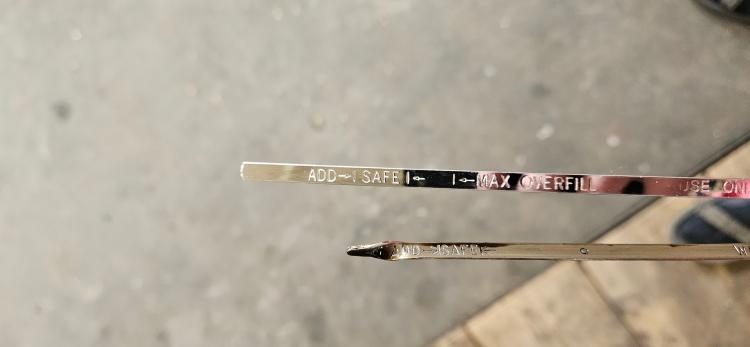  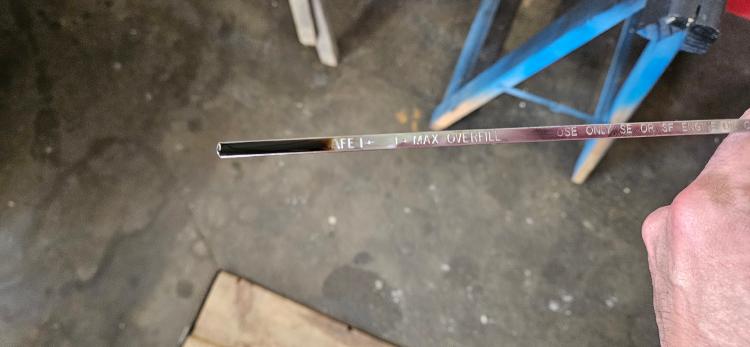 Now I've got a reading, so it seems to fit.
René's Profile
Bronco 1986 Ford Bronco XLT 302/347 stroker with 351W EEC-IV and 351W factory cam C6 gearbox. Jeep 1986 Jeep CJ7 256 I6 with T5 gearbox. Buggy 1972 HAZ Buggy 122 Ford Cologne V6 Baron 1994 Chrysler LeBaron convertible 183 V6 4-speed automatic |
|
Administrator
|
Well done!

Gary, AKA "Gary fellow": Profile
Dad's: '81 F150 Ranger XLT 4x4: Down for restomod: Full-roller "stroked 351M" w/Trick Flow heads & intake, EEC-V SEFI/E4OD/3.50 gears w/Kevlar clutches
|
| Edit this page |

